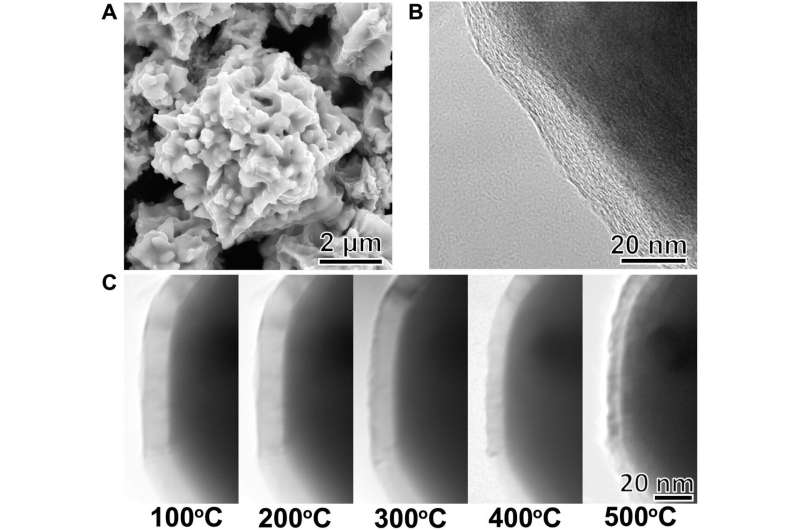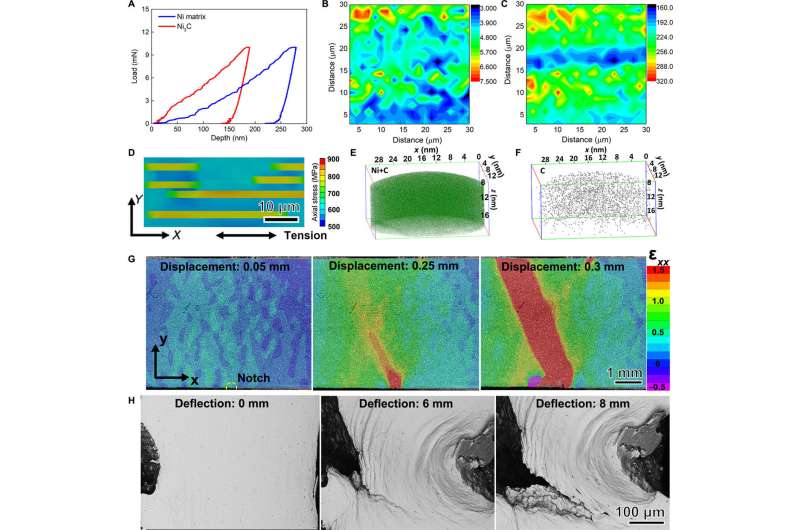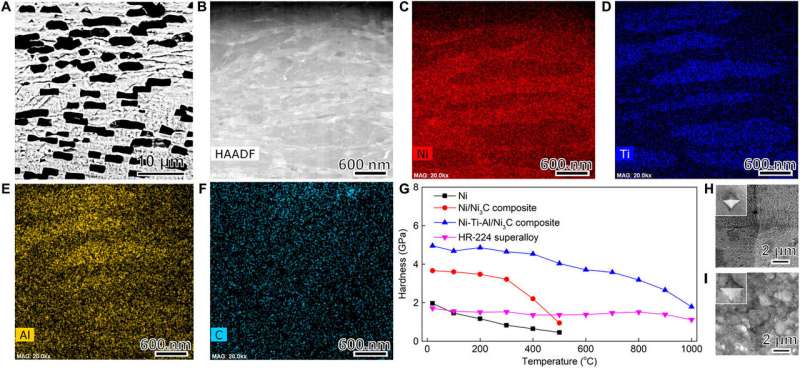June 11, 2019 feature
Bioinspired Materials—Graphene-enabled nickel composites

Bioinspired engineering strategies rely on achieving the combined biological properties of strength and toughness inherent in nature. Tissue engineers and materials scientists therefore aim to construct intelligent, hierarchical biomimetic structures from limited resources. As a representative material, natural nacre maintains a brick-and-mortar structure that allows many viable toughening mechanisms on multiple scales. Such naturally occurring materials demonstrate an outstanding combination of strength and toughness, unlike any synthetic, engineered biomaterial.
In a recent study, Yunya Zhang and co-workers at the departments of Mechanical and Aerospace Engineering, Materials Science and Atom-Probe Tomography in the U.S. developed a bioinspired Ni/Ni3C composite to mimic nacre-like brick-and-mortar structure with Ni powders and graphene sheets. They showed that the composite achieved 73 percent increase in strength with only a 28 percent compromise in ductility to indicate a notable improvement in toughness.
In the study, the researchers developed optimized material of graphene-derived, nickel- (Ni), titanium- (Ti) and aluminum- (Al) based composites (Ni-Ti-Al/ Ni3C composite) that retained high hardness of up to 1000 °C. The materials scientists unveiled a new method in the work to fabricate smart 2-D materials and engineer high-performance metal matrix composites. The composites displayed a brick-and-mortar structure via interfacial reactions to develop functionally advanced Ni-C based alloys for high-temperature environments. The results are now published in Science Advances.
Next-generation materials should inherently combine properties of strength and toughness, although their pursuit results in a compromise between hardness and ductility. In engineered materials, an initiated fracture can propagate rapidly without any shield, whereas biological structures can allow hierarchical architectures made of non-toxic and limited resources to deviate crack opening. A common example is mother-of-pearl or nacre, composed of aragonite (form of CaCO3), platelets and biopolymer. In the brick-and-mortar structure, the aragonite platelets act as bricks for load bearing, and the biopolymer acts as a mortar binding the aragonite platelets together. During fracture in nacre, the structure of mineral bridges can shield the crack opening, while biopolymer layers dissipate the fracture energy to prevent large-scale delamination.
![Microstructure of the graphene-enabled Ni/Ni3C composite. (A) SEM image of cold-rolled Ni/Ni3C composite, showing brick-and-mortar structures. (B) Fracture surface of Ni/Ni3C composite, showing laminated structure constructed by elongated dimples. (C) Low-magnification TEM image, showing a large second-phase particle embedded in the Ni matrix. (D) After cold rolling, Ni grains were deformed into long stripes with the thickness ranging from 100 to 300 nm. (E) Two-beam diffraction dark-field image of the Ni matrix, showing a high concentration of dislocations. (F) Close-up observation of the Ni/Ni3C boundary. (G) HRTEM image of the interface between Ni and a second-phase particle, revealing a transition zone. (H) Ni3C crystal on [−110] plane. (I) HRTEM image of the [−110] plane of Ni3C particle, showing identical atomic arrangement as in the Fig. 2H. (J) Schematic illustration of the formation of Ni/Ni3C composite with a brick-and-mortar structure. Credit: Science Advances, doi: 10.1126/sciadv.aav5577 Bioinspired Materials - Graphene-enabled Nickel composites](https://scx1.b-cdn.net/csz/news/800a/2019/2-bioinspiredm.jpg)
Materials scientists previously attempted to mimic the architecture of nacre with remarkable success. However, the intrinsically low plasticity of ceramics and polymers used, limited their potential mechanical activity. Researchers therefore expected to clone nacre's architecture with stronger constituents such as metal incorporated composites, in a more promising yet challenging task. Scientists previously used Nickel (Ni) and its alloys in diverse applications due to compatibility in high temperatures and extreme environments with outstanding mechanical performance and stability. In the present work, therefore, Zhang et al. investigated if graphene-enabled, high-performance Ni matrix composites with nacre-like, brick-and-mortar structure could be engineered by scalable and feasible procedures.
For this, Zhang et al. first formed a graphene-delivered Ni/Ni3C composite with a characteristic bioinspired, brick-and-mortar architecture using conventional powder metallurgy. They homogenously coated Ni powders with graphene during shear mixing and freeze drying and dissolved carbon into Ni at high temperatures to facilitate the sintering process. The Ni3C platelets formed during the process served as major load bearers, strengthening the composites, while the Ni matrix ensured ductility.

Due to the mix of strengthening and toughening mechanisms introduced in the method, the final sample showed an improved strength of 73 percent and only 28 percent reduction in ductility to cause notable toughness enhancement. Zhang et al. then included titanium (Ti) and aluminum (Al) in the graphene-derived composite to form Ni-Ti-Al/ Ni3C as a superalloy. The scientists propose to use the 2-D material enabled powder on different material constituents to create possibilities for new metal matrix composites.
They then conducted tests to investigate the microstructure and mechanical performance of graphene-enabled Ni/ Ni3C composites using energy-dispersive X-ray spectroscopy (EDS) and high-resolution transmission electron microscopy (HRTEM). They confirmed the composition of the new material and showed that the material did not break during the process of intricate manufacture. The graphene-derived Ni/Ni3C composites showed outstanding mechanical performance, observed using dog bone shaped samples of the composites. The scientists used the combined strength and ductility in the present work to indicate that the bioinspired brick-and-mortar architecture efficiently mitigated the conflict between strength and toughness.

To understand the stiffening, strengthening and toughening mechanisms of the graphene-derived Ni/ Ni3C composite, Zhang et al. conducted nanoindentation studies and obtained the Young's modulus of the material. They showed that the Ni3C platelets enhanced the Young's modulus of the novel material for increased hardness. The resulting structures showing hard and reduced modulus maps to present an alternating hard-soft-structure. Then using atom probe tomography (APT) maps, they showed homogenously dispersed carbon atoms in the nickel matrix.
The graphene-derived Ni/Ni3C composite showed obvious plastic deformation and higher toughness compared with pure Ni, the structural integrity of the new material could deviate cracks to prevent their opening, much like natural nacre. The scientists also showed the appearance of metal bridges for effective crack deflection, where the layered architecture blunted the crack tip, preventing further crack propagation to experimentally prove the brick-and-mortar architecture of Ni/ Ni3C contributing to toughness and ductility without crack induction.

Zhang et al. used Ni alloys due to their outstanding capability to withstand high temperatures and creep resistance. To verify high temperature performance, the scientists added titanium (Ti, 2 percent) and aluminum (Al, 2 percent) into the Ni/graphene powders for sintering. The resulting Ni-Ti-Al/Ni3C composite also showed brick-and-mortar architecture and stripe-like-grains. The earlier Ni/ Ni3C composites maintained a high hardness from room temperature to 300 °C, although afterwards the hardness rapidly decreased. In comparison, the Ni-Ti-Al/Ni3C composite developed thereafter, showed no hardness reduction up to 500 °C. The new composites were relatively smooth at room temperature and showed oxidized surfaces with irregular particles at 1000 °C. Based on the alloy recipes and heat treatments introduced in the study, the scientists propose using the novel composites to engineer the next-generation superalloys for potential temperature elevated applications, including aircraft gas turbines and spacecraft airframes.
In this way, Zhang and colleagues designed and developed a prototypical graphene-derived Ni/Ni3C composite with nacre-inspired brick-and-mortar architecture. They conducted extensive characterization studies to investigate and understand the material properties of the newly developed composites. The Ni-Ti-Al/Ni3C composite showed superior strength at 1000 °C compared to commercial superalloys. The scientists envision this promising new strategy to design and synthesize advanced, bioinspired materials to achieve exceptionally high mechanical robustness for a wide-range of applications in materials science and multidisciplinary fields.
More information: Yunya Zhang et al. Bioinspired, graphene-enabled Ni composites with high strength and toughness, Science Advances (2019). DOI: 10.1126/sciadv.aav5577
Sungbaek Seo et al. Significant Performance Enhancement of Polymer Resins by Bioinspired Dynamic Bonding, Advanced Materials (2017). DOI: 10.1002/adma.201703026
Ulrike G. K. Wegst et al. Bioinspired structural materials, Nature Materials (2014). DOI: 10.1038/nmat4089
E. Munch et al. Tough, Bio-Inspired Hybrid Materials, Science (2008). DOI: 10.1126/science.1164865
Journal information: Science Advances , Advanced Materials , Nature Materials , Science
© 2019 Science X Network


















